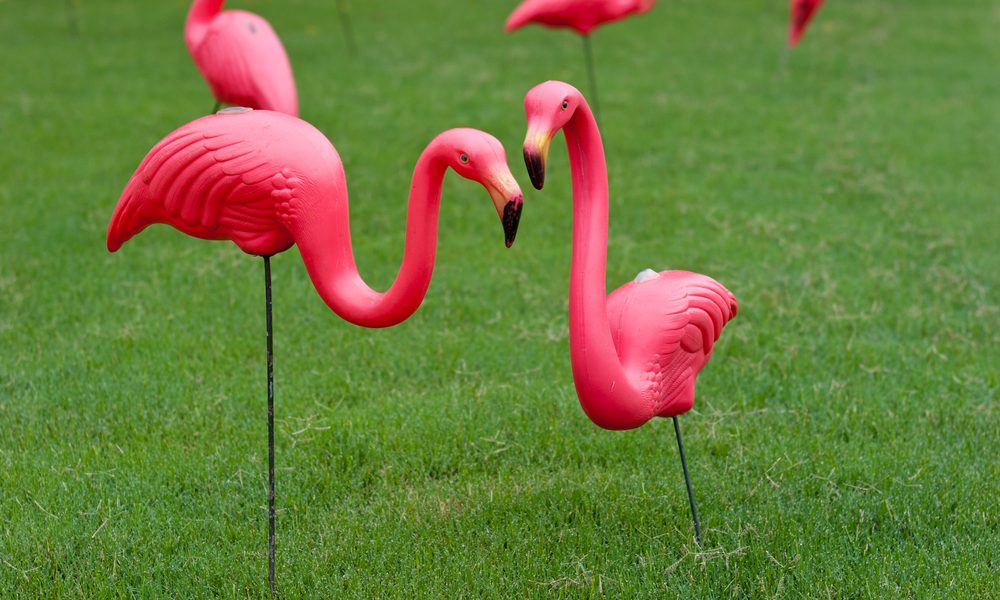Arts & Culture
Inventor of the Plastic Pink Flamingo Passes Away
John Waters discusses what the one-legged lawn ornament meant to him and Baltimore.
Baltimore is a city of iconic symbols. We have Poe and Boh. We have the Orioles. We have Formstone and painted screens. And, of course, we have the pink flamingo. Over the years, the mid-century lawn ornament has cemented itself in our city’s narrative, largely thanks to our own auteur John Waters and his 1972 film Pink Flamingos.
“When I grew up, I think my mother, who was great at the tyranny of good taste, mentioned her disdain for lawn ornaments, especially pink flamingos,” Waters says. “That may have been the beginning of my obsession with them, because whatever I was told I wasn’t supposed to like, I always did.”
On Monday, the plastic bird’s inventor, Don Featherstone, passed away at the age of 79, nearly 60 years after his famed flamingo first came off the assembly line. Fittingly surnamed, Featherstone was not a Baltimore native but rather from Massachusetts. He attended art school there, honing his craft as a sculptor, before ultimately landing a job at a large manufacturer of lawn and garden decorations. One of his first assignments was to create the neon, umbrella-shaped bird, which debuted in 1957, and was soon immortalized in American culture.
At the time, post-World War II America was in a state of suburban sprawl, with baby-boom desire driving development of nuclear dream homes. All across the country, houses looked the same, but front lawns were a way to keep up with the Joneses and also stand apart. With a burgeoning consumer society came the embrace of plastic and mass production, and hence, Featherstone’s tour de force. From California to Charm City, families welcomed the bright, beloved bird into their yards.
By the 1960s and ’70s, however, the flamingo’s mainstream popularity waned. Hippies opposed the use of plastic, and what had once been a symbol of taste quickly devolved into a tchotchke of tackiness. Just as Waters’ film was banned in theaters, some neighborhood associations started to ban the eyesores in their communities.
“I liked [pink flamingos] because the ’50s had not been revived yet,” says Waters. “When we made Pink Flamingos in the fall of ’71, nobody collected ’50s stuff—it was before ‘modern-antiques’ was even a term—and thrift shops were filled with it.
Everybody was collecting ’30s and ’40s stuff—even hippies dressed like they were the gold diggers of ’33—but nobody wanted to look like the ’50s. Later, [pink flamingos] became like the hula-hoop, they became a huge fad, but they’ve gone through many, many changes over the years.”
Through bouts of popularity all across the country, the pink flamingo has remained bound to our city, at one point or another designating Hampden as its unofficial urban district, which proudly wears the honor. (As does Madison, Wisconsin, whose council named the plastic pink flamingo their official city bird.)
Waters notes that Pink Flamingos production designer Vincent Peranio, who went on to do Homicide, Cecil B. Demented, and The Wire, found them for the film, along with other set pieces like a plate that read “God Bless Our Mobile Home.”
“But it was always going to be called Pink Flamingos because it was a very calm title for a movie that was the opposite,” he says. “And at the time, pink flamingos subtly questioned taste. But then it went on to become: yuppies have it on their lawn! That’s when I gave all mine away . . . I think when it was innocent, it was much more touching and influential.”
Up near The Avenue, pink flamingo populations are still alive and well. There are flamingos tucked into every corner of the neighborhood’s annual HonFest, on the treetops of 34th Street during the holidays, and, of course, in Cafe Hon, first opened in 1992, with its flamingo chandeliers, cocktails, and prodigious façade (which caused the Flamingogate of 2009).
“I would’ve loved to have had my picture taken with him under our big pink flamingo,” Café Hon owner Denise Whiting says of Featherstone.
But best of all, even as the country mourns the loss of the inventor (on Wednesday, Featherstone graced the cover of The New York Times), his creative legacy lives on—those plastic feathered friends forever emblazoned in American memory as a symbol of novelty, and still stuck, neck arched and one-legged, into the Baltimore grass.
